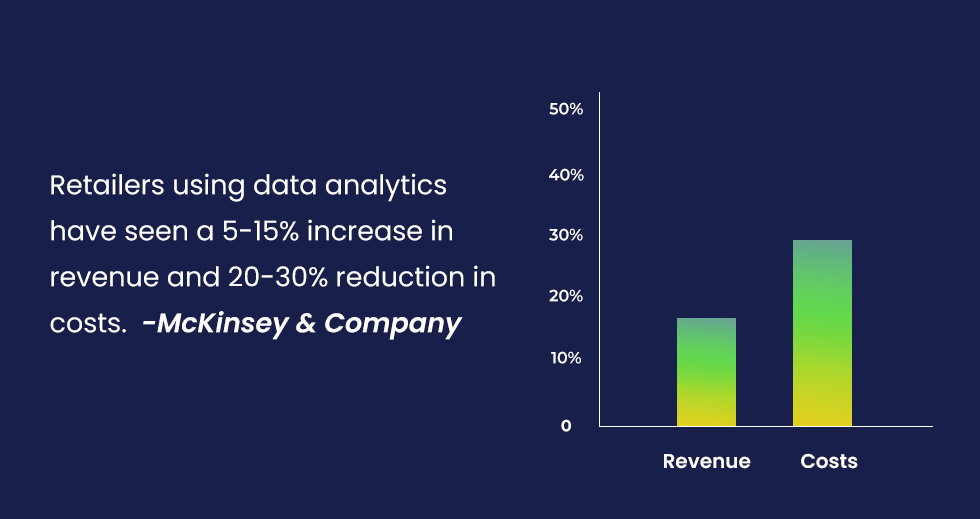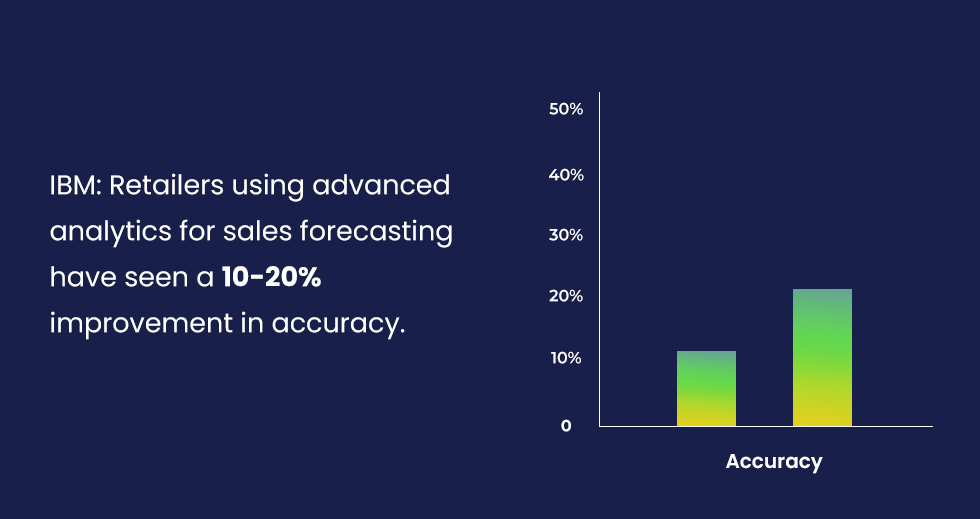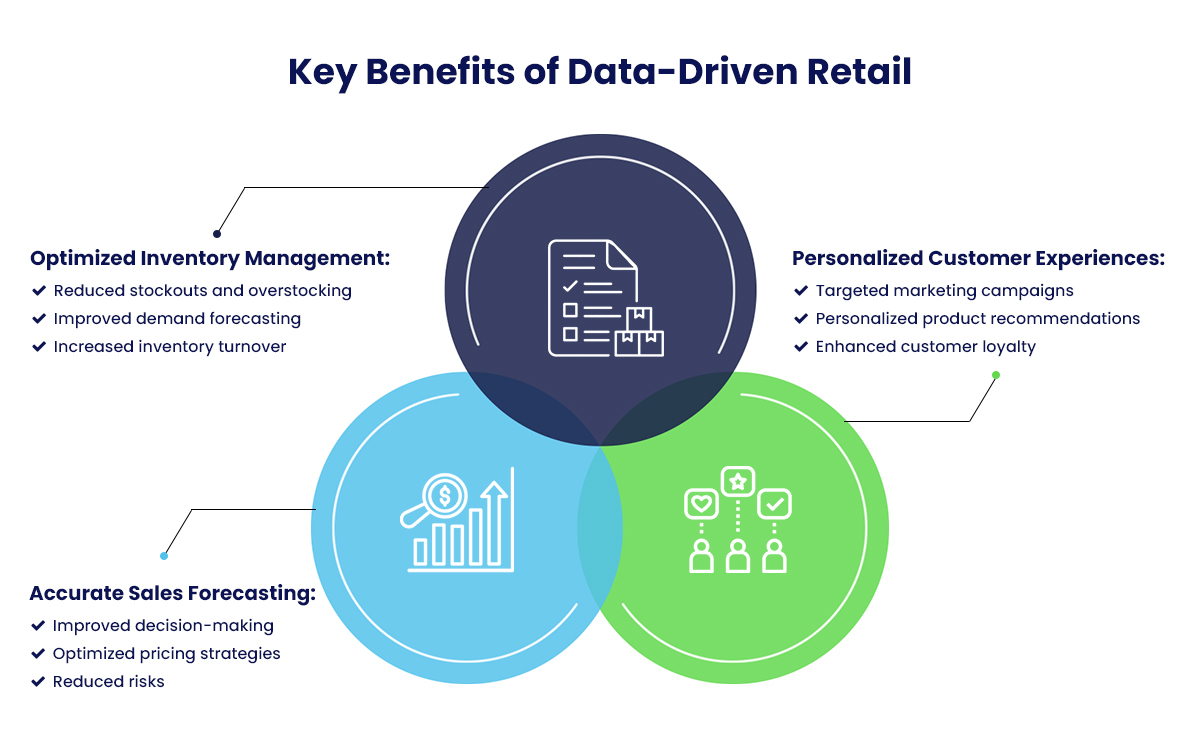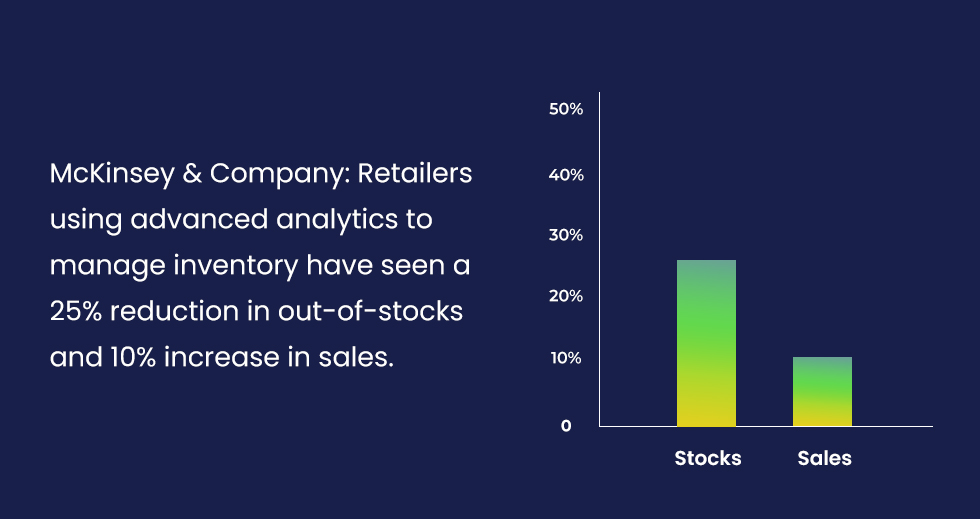Imagine a world where retailers could anticipate customer needs before customers themselves! A world where shelves were never empty and products were always in stock. Where marketing campaigns were so personalized that they felt like a one-on-one conversation. This isn’t science fiction; it’s the future of retail, powered by the transformative potential of data analytics.

Challenges Faced by Retailers Without Data
Retailers who fail to leverage data analytics can face significant challenges that can negatively impact their business performance. Some of the key challenges include:
- Stockouts and overstocking: Without accurate demand forecasting and inventory management, retailers may experience stockouts, leading to lost sales and customer dissatisfaction. Conversely, overstocking can tie up capital and increase holding costs.
- Inefficient operations: Manual processes and lack of visibility into inventory levels and customer behavior can lead to inefficient operations and increased costs.
- Limited customer insights: Retailers without data-driven insights may struggle to understand their customers’ preferences, behaviors, and needs, making it difficult to personalize their offerings and marketing campaigns.
- Missed opportunities: Without the ability to analyze sales trends and identify emerging opportunities, retailers may miss out on growth potential.
Optimizing Inventory Management with Data
Inventory management is a critical function for any retailer, as it directly impacts profitability and customer satisfaction. Traditional inventory management methods often rely on manual processes and guesswork, leading to stockouts, overstocking, and increased costs. By leveraging data analytics, retailers can optimize their inventory management strategies and achieve significant benefits.
Real-time Inventory Tracking:
- Visibility: Real-time inventory tracking provides retailers with a clear and accurate view of their stock levels across all locations.
- Efficiency: Retailers can streamline operations and save time by knowing their stock, reducing the need for manual inventory counts.
- Accuracy: Real-time tracking helps to prevent stock discrepancies and ensures that inventory records are always up-to-date.
70% Gartner: of retailers believe that real-time inventory visibility is critical for improving customer satisfaction.
Demand Forecasting and Replenishment:
- Predictive analytics: Retailers can use historical sales data, customer behavior, and external factors to accurately predict future demand for their products.
- Optimized replenishment: Based on demand forecasts, retailers can automate their replenishment processes, ensuring that products are ordered and delivered at the right time and in the right quantities.
- Reduced stockouts and overstocking: By forecasting demand more accurately, retailers can minimize the risk of stockouts and overstocking, which can lead to lost sales and increased costs.
Preventing Stockouts and Overstocking:
- Alert systems: Retailers can set up automated alerts for low or high inventory, enabling timely corrective action.
- Optimized allocation: By analyzing sales data and customer preferences, retailers can allocate inventory effectively, ensuring products are available where needed most.
- Reduced costs: Preventing stockouts and overstocking reduces costs from expedited shipping, lost sales, and markdowns.
Personalizing Customer Experiences Through Data
In today’s hypercompetitive retail world, delivering personalized customer experiences is essential for driving loyalty and increasing sales. By leveraging data analytics, retailers can gain a deeper understanding of their customers’ preferences, behaviors, and needs, enabling them to tailor their offerings and interactions accordingly.
Customer Segmentation and Targeting:
- Customer profiles: Retailers can create detailed customer profiles based on demographic information, purchase history, browsing behavior, and other relevant data points.
- Segmentation: By segmenting their customer base into distinct groups, retailers can identify target audiences with specific needs and preferences.
- Targeted marketing: Retailers can develop targeted marketing campaigns that resonate with each customer segment, increasing the likelihood of conversion and customer satisfaction.
Personalized Product Recommendations:
McKinsey & Company: Retailers who excel at personalization can increase revenue by 15%
- Recommendation engines: Retailers can use recommendation engines powered by machine learning to suggest products that are likely to interest their customers based on their past purchases, browsing history, and preferences.
- Increased sales: Personalized product recommendations can drive upsell and cross-sell opportunities, leading to increased sales and customer satisfaction.
- Improved customer experience: By offering relevant product suggestions, retailers can provide a more personalized and engaging shopping experience.
71% Salesforce customers expect brands to provide personalized experiences.
Tailored Marketing Campaigns:
- Personalized messaging: Retailers can send personalized email campaigns, SMS messages, and other marketing communications that are tailored to the individual preferences and interests of each customer.
- Increased engagement: Personalized marketing campaigns are more likely to capture customer attention and drive engagement, leading to higher open rates, click-through rates, and conversions.
- Enhanced customer loyalty: By delivering relevant and timely marketing messages, retailers can build stronger relationships with their customers and foster loyalty.
Predicting Sales Trends with Data
Accurate sales forecasting is essential for retailers to make informed decisions about inventory levels, pricing, marketing strategies, and resource allocation. By leveraging data analytics, retailers can gain valuable insights into sales trends, identify key influencers, and mitigate risks.
Sales Forecasting Techniques:
- Time series analysis: Retailers can analyze historical sales data to identify patterns, trends, and seasonality.
- Statistical modeling: They can use statistical models to forecast future sales based on various factors, such as economic indicators, promotional activities, and competitive landscape.
- Machine learning: Retailers can employ machine learning algorithms to analyze large datasets and identify complex relationships between variables, leading to more accurate sales forecasts.
71% Salesforce customers expect brands to provide personalized experiences.
Identifying Key Influencers on Sales:
- Correlation analysis: Retailers can identify correlations between sales and various factors, such as pricing, promotions, weather, and economic conditions.
- Customer behavior analysis: They can analyze customer behavior data to understand what drives purchasing decisions and identify key influencers on sales.
- Competitive analysis: Retailers can track the sales and marketing activities of their competitors to identify trends and opportunities.
Scenario Planning and Risk Mitigation:

- Scenario modeling: Retailers can create different scenarios based on various assumptions about future conditions, such as economic growth, competitive activity, and market trends.
- Risk assessment: They can assess the potential risks associated with each scenario and develop strategies to mitigate them.
- Informed decision-making: By understanding potential risks and opportunities, retailers can make more informed decisions about their business strategies.

Case Studies: Successful Data-Driven Retail Transformations
To illustrate the power of data-driven retail, here are some examples of retailers who have successfully transformed their businesses through the effective use of data analytics.
Walmart: Leveraging Data for Supply Chain Optimization
Walmart has been a pioneer in using data analytics to optimize its supply chain. By analyzing vast amounts of data on sales, inventory levels, and transportation costs, Walmart has been able to:
- Improve inventory management: Walmart’s data-driven approach has enabled them to reduce stockouts and overstocking, resulting in significant cost savings.
- Optimize transportation routes: By analyzing historical transportation data, Walmart has been able to identify more efficient routes, reducing fuel consumption and transportation costs.
- Enhance demand forecasting: Walmart’s predictive analytics capabilities allow them to accurately forecast demand for products, ensuring that they have the right amount of inventory in the right places at the right time.
Target: Personalizing Customer Experiences
Target has been successful in using data analytics to personalize customer experiences and drive sales. By analyzing customer purchase history, browsing behavior, and demographic information, Target has been able to:
- Create targeted marketing campaigns: Target has developed personalized marketing campaigns that resonate with specific customer segments, increasing engagement and conversion rates.
- Offer personalized product recommendations: Target’s recommendation engine suggests products that are likely to interest customers based on their past purchases and preferences.
- Optimize store layouts: By analyzing customer traffic patterns and product popularity, Target has been able to optimize store layouts to improve customer flow and increase sales.
Amazon: Using Data for Predictive Analytics
Amazon is a master of using data analytics to drive growth and innovation. By analyzing vast amounts of data on customer behavior, sales trends, and market conditions, Amazon has been able to:
- Predict future sales: Amazon’s predictive analytics capabilities allow them to accurately forecast demand for products, ensuring that they have the right inventory levels.
- Optimize pricing: Amazon’s data-driven pricing strategies enable them to dynamically adjust prices based on demand, competition, and customer behavior.
- Develop new products: Amazon uses data analytics to identify emerging trends and customer needs, enabling them to develop new products that meet market demand.
These case studies demonstrate the tangible benefits that retailers can achieve by embracing data-driven approaches. By leveraging data analytics, businesses can gain a competitive edge, enhance customer satisfaction, and drive sustainable growth.
Implementing Data-Driven Strategies: Best Practices
To successfully leverage data analytics for retail transformation, it is essential to follow best practices for data collection, analysis, and integration into decision-making processes.
Data Collection and Quality Assurance:
- Data sources: Identify and collect data from various sources, including point-of-sale systems, customer relationship management (CRM) software, loyalty programs, social media platforms, and market research data.
- Data quality: Ensure that collected data is accurate, complete, and consistent. Implement data cleansing and validation procedures to eliminate errors and inconsistencies.
- Data governance: Establish data governance policies and procedures to manage data quality, security, and access.
Data Analysis and Visualization:
Data mining and analytics tools: Utilize advanced data mining and analytics tools to extract valuable insights from large datasets.
- Visualization techniques: Employ effective visualization techniques, such as charts, graphs, and dashboards, to communicate data-driven insights to stakeholders.
- Key performance indicators (KPIs): Define and track relevant KPIs to measure the effectiveness of data-driven initiatives.
Integrating Data into Decision-Making:
- Data-driven culture: Foster a data-driven culture within the organization, encouraging employees to use data to inform their decision-making.
- Collaboration: Facilitate collaboration between data analysts, business leaders, and other stakeholders to ensure that data-driven insights are effectively integrated into decision-making processes.
- Iterative approach: Adopt an iterative approach to data analysis and decision-making, allowing for continuous improvement and adaptation based on new insights.
By following these best practices, retailers can maximize the value of their data and drive successful business outcomes.
Conclusion: Leveraging Charter Global for Data-Driven Retail Success
As the retail landscape continues to evolve, data is the key to leveraging the full potential of businesses. By embracing data-driven strategies, retailers can transform their operations, enhance customer experiences, and drive sustainable growth.
Charter Global can be your trusted partner in this transformation. Our comprehensive suite of data analytics and consulting services can help you:
- Collect and analyze data: Our experts can help you gather, clean, and analyze data from various sources to extract valuable insights.
- Develop data-driven strategies: We can work with you to develop tailored data-driven strategies that align with your business objectives.
- Implement data-driven initiatives: Our team can assist you in implementing data-driven initiatives, such as inventory optimization, personalized marketing, and sales forecasting.
- Measure and optimize performance: We can help you track key performance indicators and optimize your data-driven strategies to achieve maximum results.
Partner with Charter Global, and discover the power of your data and position your retail business for long-term success. Contact us today to learn more about how our services can help you transform.
Book your personalized consultation now.
Or mail us at [email protected] or call +1 770.326.9933



